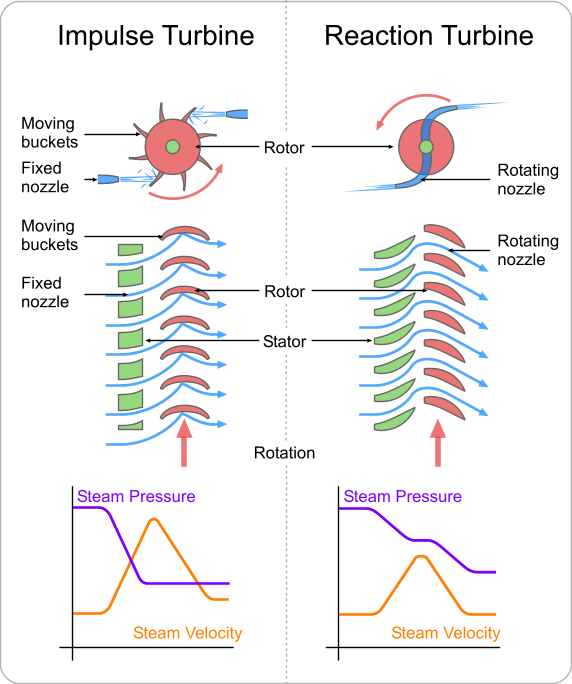A reaction turbine is a type of Steam Turbine that works on the principle that the rotor spins, as the name suggests, from a reaction force rather than an impact or impulse force.
In a reaction turbine there are no nozzles to direct the steam like in the impulse turbine.
The fixed blades, which are the same shape as the moving blades, are mounted to the outer casing where the rotor revolves and are set to guide the steam into the moving blades. Below is a simple diagram of reaction turbine blades:
In the case of reaction turbine, the moving blades of a turbine are shaped in such a way that the steam expands and drops in pressure as it passes through them. As a result of pressure decrease in the moving blade, a reaction force will be produced. This force will make the blades to rotate.
A reaction turbine has rows of fixed blades alternating with rows of moving blades. The steam expands first in the stationary or fixed blades where it gains some velocity as it drops in pressure. Then enters the moving blades where its direction of flow is changed thus producing an impulse force on the moving blades. In addition, however, the steam upon passing through the moving blades, again expands and further drops in pressure giving a reaction force to the blades.
This sequence is repeated as the steam passes through additional rows of fixed and moving blades.
Note that the steam pressure drops across both the fixed and the moving blades while the absolute velocity rises in the fixed blades and drops in the moving blades.
The distinguishing feature of the reaction turbine is the fact that the pressure does drop across the moving blades. In other words, there is a pressure difference between the inlet to the moving blades and the outlet from the moving blades.
Reaction Steam Turbine Shandong Qingneng Power Co., Ltd. , https://www.steamturbine.be
Reaction Turbine Principle:

Reaction Turbine Working:
Special Aspects of Reaction Turbines
Congratulations to my company's "Taifeng" brand hydraulic valve won the high quality brand of machinery industry
Warmly congratulate my company's "Taifeng" brand hydraulic valve won the high quality brand of machinery industry. Time: May 19, 2015 To further implement the spirit of a series of quality brand building of the Party Central Committee and the State Council and General Secretary Xi Jinping's "Three Transformations" The important directive was that the 2015 national machinery industry brand strategy promotion work conference was held in Beijing on April 28th. The conference commended the quality products of the 72 brands that emerged from the 65 brand-building activities. My company's "Taifeng" brand hydraulic valve won the high quality brand machinery industry. Copyright: Shandong Taifeng Hydraulic Co., Ltd.